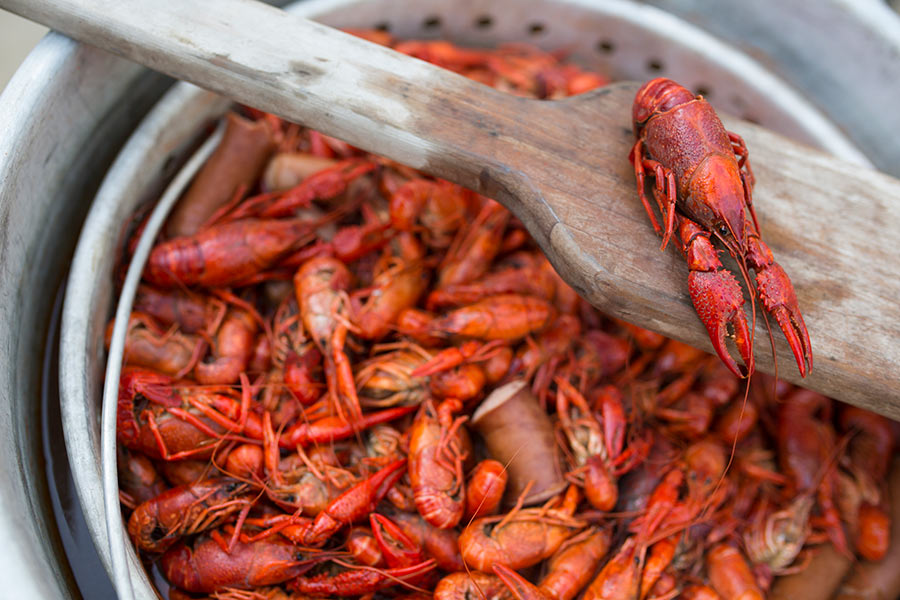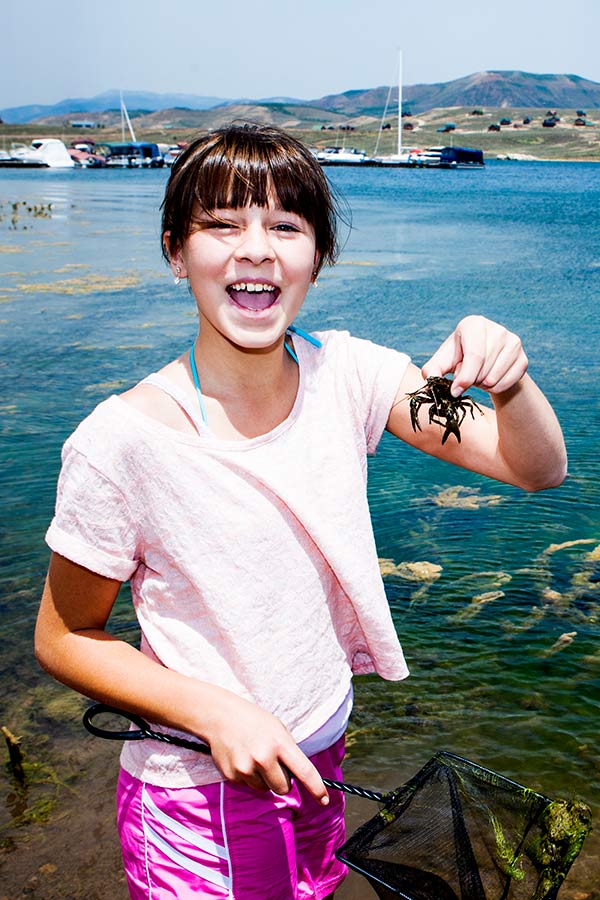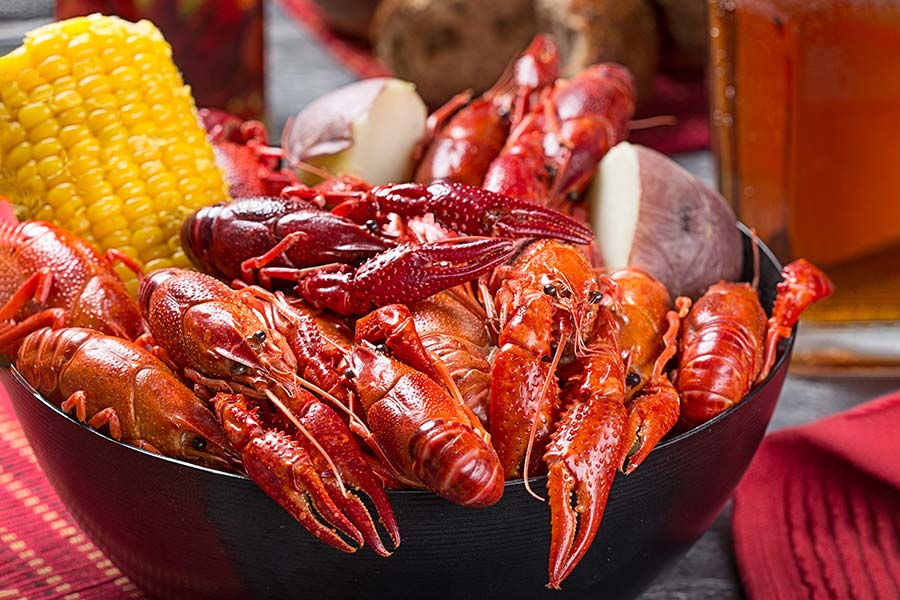Boiled crayfish
Fun to catch, great to eat
By Joseph H. Smart
Special to the DWR
This recipe is taken from Crayfishing for Food and Fun, a booklet Mr. Smart wrote for the Division of Wildlife Resources in 1991.
See the booklet's adapted page on this website for more crayfish recipes, as well as where to find crayfish and how to catch them.
Crayfish, crawfish, crawdads or freshwater lobsters. Whatever you call them, these little crustaceans are abundant in many Utah reservoirs and streams. They're fun to catch and great to eat.
Crayfish are the centerpiece of Creole or Cajun cuisine in New Orleans, a must during the national autumn festival in Sweden, equated with lobster in French gourmet restaurants, and from earliest times, a worldwide delicacy wherever they could be found. In fact, in Larousse Gastronomique, the bible of French gourmet cooking, there are only 10 recipes for shrimp and three for crab, but 25 for crayfish! And not only do crayfish taste good, they're good for you — loaded with vitamins, minerals and high-quality proteins.
Ingredients
- Freshly caught crayfish (about 24 per serving)
- 1 gallon of water
- ½ cup of salt
- Lemon juice (if you decide to remove the tails)
Note: Crayfish are best eaten immediately after being caught, so you'll have to decide how many people your catch will serve. If you have extra servings, invite your friends to a crayfish bash!
Directions
Part 1: Catching and preserving
First, you'll need to catch some crayfish, and I've written instructions for doing so. Once you've caught them, steps must be taken to kill and preserve them. Utah law forbids the transportation of live crayfish. They must be killed where they are caught to prevent their being introduced into waters where they are not wanted.
Because crayfish meat deteriorates rapidly, it is important to ice it quickly and keep it at a temperature of 40° F or below until processed.
Cleanliness is equally important to maintaining freshness and flavor. Crayfish, like crab and lobster, have a rough shell and many joints where silt and algae can lodge. Thorough cleaning in the field is not practical, nor is it important if the crayfish body is kept intact. If, however, only the tails are kept, contamination may get into the meat.
Another good reason for saving the body is the super-tasty meat in the claws and the nutritious, delicious internal organs and juices, which can be used to flavor some dishes and soups.
The essential steps to preserve the texture and flavor of the precious meat are as follows:
- Keep the accumulating catch alive until the end of the fishing day. As crayfish are caught, pack them tightly in a large container between layers of moist fabric, such as gunnysacks. This reduces cannibalism among the crayfish. It is also a good idea to put ice between the layers of fabric, but not directly on the crayfish.
- At the end of the day, discard any dead or mutilated crayfish, and kill the keepers painlessly and quickly by stabbing each one firmly with a kitchen knife on the top, where the head joins the body.
- In a large pot with plenty of cold, clean water, wash the whole crayfish vigorously to remove surface dirt, even if you only wish to keep the tails.
- Rinse thoroughly in another pot of fresh, cold water. Now remove the tails, if you want.
- Pack whole crayfish or crayfish tails in alternate layers of ice and filter them in a large, pre-chilled ice chest so they do not touch ice or stand in water.
- The chest should have a false bottom with at least four inches of space under it. Wood slats or hardware cloth nailed to 1" × 2" crossmembers will serve that purpose. Lay a plastic garbage bag on the bottom to prevent water from splashing upward, then place crayfish two or three deep.
- Cover with plastic or newspaper, add two inches of ice, cover with another layer of plastic or newspaper, and then add more crayfish. Repeat until all your crayfish are packed. Top with ice.
- Leave the ice chest drain valve open until you are ready to load your vehicle. After the ice chest is packed, don't open it again until you are ready to process the crayfish or transfer them to other refrigeration.
Part 2: Washing and deveining
As soon as you bring your catch home, put the ice chest in a cool place and open the drain valve. The faster you can process the crayfish, the better. If you can't process them for several hours, transfer the crayfish to plastic bags and store them in a cold refrigerator.
Discard any crayfish that are too soft or otherwise suspect. Scrub them in very cold water, particularly their bottoms, until they look clean. Rinse thoroughly. To remove the thin, black intestine from the tail, grasp the top middle tail fin (there are five fins), twist and pull. The vein should come out with the fin. Soak the crayfish in a strong salt solution for five minutes or more to further cleanse them and firm their flesh. Rinse.
Now, you must decide whether to leave the crayfish whole or remove the tails. (I prefer the former.)
If you remove the tails, pack them uncooked in bags and freeze quickly. Peeled tails should be dipped in a solution of one quarter cup lemon juice to one cup water to prevent discoloration. Freeze a few whole crayfish for decorating dishes you prepare later.
Part 3: Cooking
If possible, cook your crayfish immediately after you wash and devein them. Even if you intend to freeze them for another day, cook them first. Here's how:
- In a large pot, add half a cup of salt to one gallon of water. Bring to a boil.
- Add about two quarts of crayfish to the pot and bring back to a boil.
- Cover the pot and let the crayfish simmer until they turn red and rise to the surface. This should take about five minutes.
- Once boiled, remove all crayfish from the pot and cook any additional batches in the same water.
Part 4: Peeling the tails and freezing
Peel the tails while the crayfish are still warm (more on this below), unless you are freezing the crayfish whole. Leave the nutrient-rich, flavorful fat attached to the tails if they are to be eaten fresh.
As I mentioned earlier, crayfish meat doesn't keep well. To freeze it, once cooked, first remove the fat from the tails to minimize spoilage. Chill the crayfish in ice water, then bag and freeze. If it's kept at a low temperature, undisturbed and in a sealed container, it will last six months to a year.
How to peel the tails
Here are some additional instructions for peeling the shell off the tails. If the tail is uncooked, slit the bottom shell from front to fins with sharp-nosed scissors. Devein as described previously, and peel off the shell. For cooked tails, proceed as follows while the crayfish are still warm from the boil:
- Separate the tail from the body by slightly twisting and pulling the tail from the head.
- Hold the tail lengthwise between your thumb and forefinger, and squeeze. You may hear the tail crack.
- Grasp the lower tailfin pads from the side and loosen by lifting up and pulling around the meat. This piece can easily be pulled off and discarded.
- Firmly grasp the last segment and tailfin with the thumb and forefinger of one hand.
- Gently pull the meat out of the shell with the other hand. The vein will pull free from the meat.
Extra appetizer
Inside the head of the crayfish, on either side, are two pockets of a substance called the "butter." The butter is brilliant yellow or orange in color and, when used in recipes calling for butter, improves both the appearance and flavor of crayfish. To remove the butter, open the crayfish head slightly and lift the butter out with a small spoon. It should be used immediately because it spoils quickly, even when frozen.
Enjoy!
This is one of many crayfish recipes — you'll find there as many recipes as there are crayfish cooks — and many recipes are held secret. I've included a few more recipes on this page and in my booklet. Happy crayfishing!










